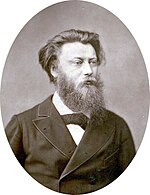Pavel Yablochkov
| Pavel Yablochkov | |
|---|---|
 |
|
| Born | September 14 [O.S. September 2] 1847 Serdobsky, Saratov region, Russian Empire |
| Died | March 31 [O.S. March 19] 1894 Saratov, Russian Empire |
| Nationality | Russia |
| Education | Military engineering-technical university, St. Petersburg |
| Engineering career | |
| Projects | Transformer |
| Awards | French Legion of Honor |
Pavel Nikolayevich Yablochkov (also transliterated as Jablochkoff) (Павел Николаевич Яблочков in Russian) (September 14 [O.S. September 2] 1847 – March 31 [O.S. March 19] 1894) was a Russian electrical engineer, businessman and the inventor of the Yablochkov candle (a type of electric carbon arc lamp) and the transformer.
Yablochkov graduated in 1866 as a military engineer from Nikolayev Engineering Institute, now Military engineering-technical university (Russian ), and in 1869 from Technical Galvanic School in Saint Petersburg. After serving in the army, Yablochkov settled in Moscow in 1873, where he was appointed Head of Telegraph Office at the Moscow-Kursk railroad. He opened up a workshop for his experiments in electrical engineering, which laid down the foundations for his future inventions in the field of electric lighting, electric machines, galvanic cells and accumulators.
Yablochkov’s major invention was the first model of an arc lamp that eliminated the mechanical complexity of competing lights that required a regulator to manage the voltaic arc. He went to Paris the same year where he built an industrial sample of the "electric candle" (French patent № 112024, 1876). It was in Paris that he developed his arc light idea into a complete system of electric lighting powered by Zénobe Gramme direct current dynamos fitted with an inverter to supply single-phase alternating current. The first public use of the Yablochkov system was in October 1877 at Halle Marengo of the Magasins du Louvre which was lit by six Yablochkov candles. By 1880, the system had grown in size to 120 lamps with 84 lit at a time powered by a 100-horsepower steam engine and had been operating every night for two and one half years.
...
Wikipedia
